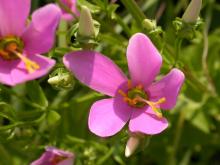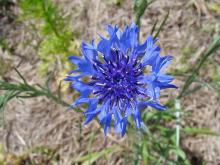Wildflowers, Grasses and Other Nonwoody Plants
Media

Species Types
Scientific Name
Lotus corniculatus
Description
Bird’s-foot trefoil forms low patches of bright yellow flowers along roadsides, having been planted to stabilize soil after road construction. Up close, it clearly has pea flowers. The leaves are cloverlike, with two leafy stipules at the base of each.
Media

Species Types
Scientific Name
Stylosanthes biflora
Description
Pencil flower is small and often overlooked. It has wiry stems, long, bristly hairs, three-parted leaves, and orangish-yellow flowers.
Media

Species Types
Scientific Name
Pedicularis canadensis
Description
Wood betony has a tight spiral of tubular, hooded yellow flowers atop a plant adorned with deeply incised, fernlike leaves that are about as attractive as the flowers themselves. In early spring, these leaves have a beautiful wine-red coloration.
Media

Species Types
Scientific Name
Lespedeza cuneata
Description
Decades ago, sericea lespedeza was introduced in hopes it would provide hay, improve pastures, stop soil erosion, and supply food and cover for wildlife. Unfortunately, it has proven to be an aggressive, invasive weed that is extremely difficult to control, escapes cultivation, and outcompetes native plants.
Media

Species Types
Scientific Name
Lespedeza virginica
Description
A bushy native perennial legume with small clusters of pink flowers, slender bush clover provides nectar for numerous insects. Several types of birds eat the seeds, and many mammals eat the foliage.
Species Types
Scientific Name
Lespedeza thunbergii
Description
Thunberg’s lespedeza is a large, nonwoody perennial shrub often cultivated as a showy, flowering ornamental. It sometimes escapes from cultivation and naturalizes in Missouri landscapes.
Media

Species Types
Scientific Name
Sabatia angularis
Description
Rose-pink, or rose gentian, is a delicately scented native wildflower with floral clusters resembling candelabras. It has square stems and clasping leaves. It is common in open Ozark woods and fields and blooms June–September.
Media

Species Types
Scientific Name
Solidago spp. (23 species in Missouri)
Description
There are 23 species of goldenrods in Missouri. They can be hard to identify to species, but as a group, the goldenrods are common and nearly unmistakable.
Media

Species Types
Scientific Name
Senna marilandica (formerly Cassia marilandica)
Description
The flowers of southern wild senna don’t look much like typical pea-family flowers, but its leaves and bean pods show the family resemblance. Look for it in moist situations, mostly south of the Missouri River.
Media

Species Types
Scientific Name
Centaurea cyanus
Description
A native of Europe, cornflower is a popular garden flower that often escapes to nearby areas. It’s used in bridal bouquets and men’s boutonnieres. Its intense blue color appears in boxes of crayons!
See Also
About Wildflowers, Grasses and Other Nonwoody Plants in Missouri
A very simple way of thinking about the green world is to divide the vascular plants into two groups: woody and nonwoody (or herbaceous). But this is an artificial division; many plant families include some species that are woody and some that are not. The diversity of nonwoody vascular plants is staggering! Think of all the ferns, grasses, sedges, lilies, peas, sunflowers, nightshades, milkweeds, mustards, mints, and mallows — weeds and wildflowers — and many more!





















